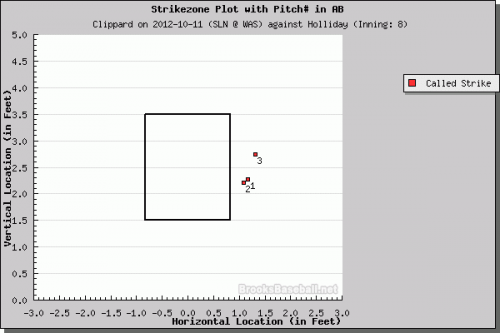Here’s Matt Holliday. It’s strike three and it was three bad calls.
Holliday’s body language speaks clearly, and his reaction is understandable. The pitch was wide, even wider than the first two pitches, both of which the umpire miscalled as strikes. Here’s the data:
The PITCHf/x technology that makes this graphic possible, whatever its value or threat to umpires, has been a boon for sabremetricians and social scientists. The big data provided can tell us not just the number of bad calls but the factors that make a bad call more or less likely.
In the New York Times, Brayden King and Jerry Kim report on their study of roughly 780,000 pitches in the 2008-09 season. Umpires erred on about 1 in every 7 pitches – 47,000 pitches over the plate that were called balls, and nearly 69,000 like those three to Matt Holliday.
Here are some of the other findings that King and Kim report in today’s article.
- Umpires gave a slight edge to the home team pitchers, calling 13.3% of their pitches outside the zone as strikes. Visitors got 12.6%.
- The count mattered: At 0-0, the error rate was 14.7%, at 3-0, 18.6% of pitches outside the zone were called as strikes, and at 0-2, only 7.3% of pitches outside the zone were called as strikes.
- All-star pitchers were more likely than others to get favorable calls…
- …especially if the pitcher had a reputation as a location pitcher.
- The importance of the situation (tie game, bottom of the ninth) made no difference in bad calls.
It seems that expectation accounts for a lot of these findings. It’s not that what you see is what you get. It’s that what you expect is what you see. We expect good All-star pitchers to throw more accurately. We also expect that a pitcher who is way ahead in the count will throw a waste pitch and that on the 3-0, he’ll put it over the plate. My guess is that umpires share these expectations. The difference is that the umps can turn their expectations into self-fulfilling prophecies.
Cross-posted at Business Insider.
Jay Livingston is the chair of the Sociology Department at Montclair State University. You can follow him at Montclair SocioBlog or on Twitter.


Comments 5
BrendaSBarrientez — April 6, 2014
We also expect that a pitcher who is way ahead in the count will throw a waste pitch and that on the 3-0, he’ll put it over the plate. My guess is that umpires share these expectations. The difference is that the umps can turn their expectations into self-fulfilling prophecies. http://qr.net/sBx9
Bill R — April 6, 2014
Understanding the nature of our mental representation of the physical world has intrigued philosophers, psychologists and others since Plato's time. Expectations, often honed through training and long-term experience, help us use our physical senses to perceive, and shape our beliefs about what is happening around us and what we understand to be true. Without such expectations the world would be a perceptual mess and we'd face sensory overload our entire lives. (Ever drive to work on automatic pilot?)
So expectations (subconsciously recalled memories perhaps) certainly shape what we "see", but that's a very good thing; it enables survival.
Here's a mental experiment for you to help put these baseball stats in perspective: Imagine what the results would be if 20 umpires were pitted against 20 middle aged adults who had never seen a baseball game before. Sure, the umps make mistakes in predictable ways, but they've learned how to perceive in a way that keeps their accuracy quotient pretty high. Judging a strike on a ball traveling 90 feet at 75 MPH is a learned skill.
Big Data Reveals Why Umpires Make Bad Calls « KellyMitchell — April 7, 2014
[…] It is Opening Day for the St. Louis Cardinals and since KellyMitchell is headquartered in St. Louis, we thought we’d share this Big Data study that reveals why some umpires make bad calls. The study finds that umpires sometimes favor pitchers based on home field, All-Star status, race, and reputation. The better the pitcher, the more often their pitches are favored and pitchers labeled as wild are given less confidence. This subconscious benefit of the doubt is what leaves some batters, like Matt Holiday, shaking their heads. […]
fork — April 7, 2014
" It’s not that what you see is what you get. It’s that what you expect is what you see. "
Love that.
Big Data Reveals Why Umpires Make Bad Calls - KellyMitchell — August 6, 2015
[…] It is Opening Day for the St. Louis Cardinals and since KellyMitchell is headquartered in St. Louis, we thought we’d share this Big Data study that reveals why some umpires make bad calls. The study finds that umpires sometimes favor pitchers based on home field, All-Star status, race, and reputation. The better the pitcher, the more often their pitches are favored and pitchers labeled as wild are given less confidence. This subconscious benefit of the doubt is what leaves some batters, like Matt Holiday, shaking their heads. […]